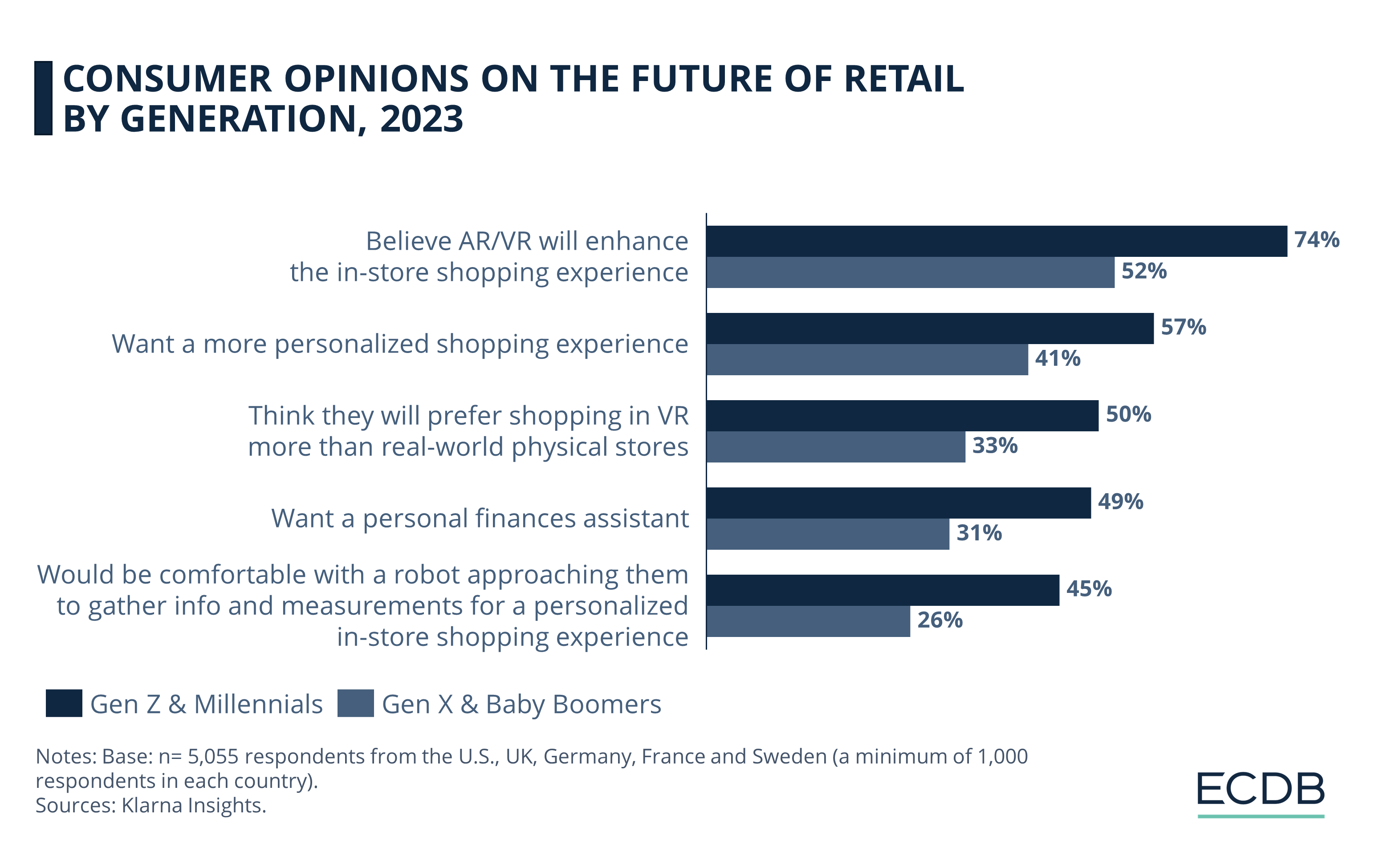Retail in 2041: Expectations of Generations, Technology & Customer Experience
Article by Cihan Uzunoglu | July 06, 2023

As the Swedish fintech company Klarna turns 18 this year, the company decided to celebrate by looking 18 years into the future and assess how the future of retail will look like.
This research, done in partnership with research agency Dynata, involved surveying a nationally representative sample of over 5,000 consumers across five countries (U.S., UK, Germany, France, and Sweden) in April 2023, with at least 1,000 respondents from each country – including both Klarna and non-Klarna users. First, we focus on Generation Z, the youngest generation involved in the study. Then, we move on to comparing the younger and older generations. Finally, we touch upon some intriguing general results from the research.
Generation Z in Shaping the Future of Retail
Colloquially known as the “smartphone generation”, Generation Z (people born between 1997 and 2012) inherently possess a deeper affiliation with technology when juxtaposed with their older counterparts, having grown up alongside the meteoric rise of these transformative gadgets. As we fast-forward 18 years to when an average individual from this cohort hits their 40s, let's take a look at their expectations of how technological leaps might shape their retail encounters.
The future of retail, as envisioned by Generation Z, is poised to be a fusion of technology and personalization. A substantial 76% of the Generation Z populace foresees augmented reality (AR) not just as a novelty, but as a tool to enrich their physical store shopping encounters. The prospect of AR is so strong among this group that 27% anticipate its ubiquitous presence in the retail landscape. What’s more, 56% of this generation are not content with a one-size-fits-all approach to retail. They express a desire for a future retail scenario that is more tailored to their individual needs. Moreover, a significant 42% are confident that this personalization will manifest itself in both physical and virtual stores, revolutionizing the way consumers engage with retailers.
As we explore further into the future of retail, the idea of delivery is also projected to transform dramatically. Two-thirds of this group predict that autonomous technology like drones and robots will take over the majority of online shopping deliveries. Lastly, Generation Z envisions a future where technology streamlines even the most personal aspects of shopping. A smaller, yet noteworthy percentage, at 23%, anticipate that the need for physically trying on apparel will become obsolete. They predict personal robots or AI assistants will efficiently determine the right clothing options to suit their physical dimensions and fashion preferences, bringing the fitting room experience directly into their homes. The future of retail, according to Generation Z, holds a seamless blend of technological advancement and bespoke customer experience.
Divergent Forecasts of Generations
In addition to the opinions of Gen Z, discussed in the previous chapter, Millennials, Gen X and Baby Boomers have varying conceptions of retail’s future. Individuals belonging to the Millennial cohort, people born between 1981 and 1996, precede the era defined by the dominance of smartphones, having witnessed the rise and standardization of personal computers and the Internet in domestic environments. They are youthful enough to have had their formative years shaped by the phenomenon of online purchasing, while simultaneously mature enough to recall the days when such a concept didn't exist. This applies similarly to Gen X members (those born between 1965 and 1980) and the Baby Boomers (those born between 1946 and 1964), who after spending their early years contemplating how their predecessors managed without the luxuries of color televisions and instant photography, have steadily acclimated to these technological advancements.

Grouped together as Gen Z & Millennials, and Gen X & Baby Boomers, the findings of Klarna’s research suggest that the former are overall more open to a future where retail is supported by technology. For instance, while almost three quarters (74%) of the younger group believes that AR / VR will enhance the in-store shopping experience, a little more than half (52%) of the older group who supports this statement. Moreover, 57% of the younger group wants a more personalized shopping experience, while the share of Gen X & Baby Boomers who feel the same is 41%. The chart below details this generational divide further.
Habits Die Hard for Some
Let’s also take a look at some other results from the research with no particular focus on any generation. A significant proportion of consumers (57%) of all ages are in agreement with the prediction that by 2041, the majority of physical stores will have transitioned to a completely cash-free model. However, technological innovations such as smart mirrors and online personas or avatars elicit mixed feelings. Around 31% of consumers express disinterest in using smart mirrors in the future, and 32% are reluctant to browse via online personas or avatars. This shows that, despite the rapid advancements in virtual reality technology, today's consumers still show a preference for real-life shopping experiences.
What’s more, about 69% would choose a physical store over a virtual one today, and it's projected that even by 2041, a sizable 58% will still favor traditional shopping methods. Additionally, a growing consumer trend towards sustainability is projected to shape the retail landscape, with a considerable number expecting to participate in the circular economy by 2041. Many consumers are optimistic that future stores will offer buyback programs (33%), with rental options following closely behind (32%), indicating a shift in retail consumption patterns towards more sustainable and less wasteful practices.
What the Next Chapter Looks Like
The future of retail is being actively shaped by a confluence of generational expectations and preferences, each generation bringing its unique digital landscape to bear on its vision of the future. Generation Z, often referred to as the "smartphone generation”, for instance, foresees a retail landscape deeply intertwined with technology. They predict a future where AR, personalization, and autonomous technology redefine both online and physical shopping experiences. Other generations, Millennials, Gen X, and Baby Boomers, although each having had unique experiences with technology, provide varying perspectives. The Millennial and Gen Z cohorts generally appear more open to a future where retail is interwoven with technology, particularly AR and personalization. In contrast, Gen X and Baby Boomers display a more restrained enthusiasm for such advancements, underscoring the diverse technological experiences that have shaped each generation.
Despite these varied visions, there are threads of consensus across all age groups. The majority of consumers foresee a future where physical stores transition to completely cash-free models. However, feelings are mixed towards certain technological innovations like smart mirrors and online avatars, suggesting that certain aspects of traditional retail, such as the tangible in-person experience, still hold value for many. Moreover, a continued preference for physical stores is anticipated to persist, even amidst rapid technological advancements. This underlines the importance of tactile experience in shopping that no amount of technology seems likely to completely replace. Taken together, these insights paint a picture of a future in which technology, personal preferences, and sustainability coalesce to shape a retail landscape that is at once innovative yet mindful of its roots and responsibilities. This complex interplay of forces promises a retail future that is as diverse and multifaceted as the people that will inhabit it.
Sources: Klarna Insights
Related insights
Article
Walmart, Amazon & Shein: Which Store Ranks First in U.S. Online Fashion?
Walmart, Amazon & Shein: Which Store Ranks First in U.S. Online Fashion?
Article
Online Car Selling & Buying: Revenues, Forecast, Top Marketplaces & Trends
Online Car Selling & Buying: Revenues, Forecast, Top Marketplaces & Trends
Article
Fashion ReCommerce in the UK: Top Categories, Generational Attitudes, Leading Shops
Fashion ReCommerce in the UK: Top Categories, Generational Attitudes, Leading Shops
Article
Zalando, Otto & About You: Revenue, Market Growth, Business Strategies
Zalando, Otto & About You: Revenue, Market Growth, Business Strategies
Article
Online Shopping vs. In-Store Shopping in Europe: eCommerce Recovers After Post-Pandemic Dip
Online Shopping vs. In-Store Shopping in Europe: eCommerce Recovers After Post-Pandemic Dip
Back to main topics